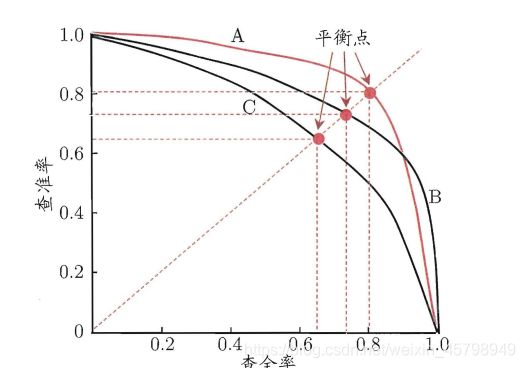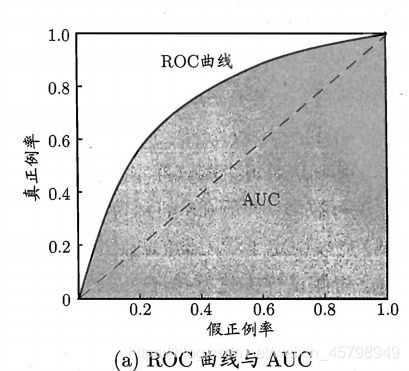算法模型的评估与tensorflow版fasterrcnn模型评价代码解析
过拟合与欠拟合
在我们训练一个机器模型之后,往往需要对此模型进行评价,一些术语需要对此进行了解。
过拟合:在训练时我们往往不希望模型对所有的数据都能得到很好的拟合,因为一旦这样往往在新的样本上表现的不一定好。
常见的形式是:训练过程损失函数逐渐收敛的很好,而测试时损失函数很大,并且不易收敛。这也说明这个模型泛化能力很差。
打个比方:平时做题训练时答得都很好,一旦考试就不会,这说明它的泛化性不够好,我们往往希望得到一个泛化性能高的模型。
导致过拟合的常见情况为学习能力过于强大,即把学习率调低一些,或者设置成为动态的学习率。
欠拟合:与过拟合相对应的,训练样本的一般性质没有学到,可以考虑加大学习率。
模型的评估方法
留出法:分配训练集与测试集,比如在目标检测时,提前按照比例分配好训练集与测试集后,根据训练出的模型及进行测试,根据预测出来的框的位置与之前标注时框的位置做一个交并比(交集与并集面积之比)通常认为比值大于0.5认为检测出来,以此来进行检测有着不足,当样本较少时,仅仅0.2的测试集不足以评估出模型的准确率。因此往往需要用到交叉验证法
交叉验证法:把数据集分成10份,
123456789份训练1第0份验证
1234567910份训练第8份验证…以次类推做10折交叉法。
混淆矩阵
错误率:分类错误的样本数占样本总数的比例
精度:分类正确样本数占样本总数的比例
| 正 ------- ------------------------- 负 | |
|---|---|
| 真T | TP---------------------------------TN |
| 假F | FP(误报)--------------------------------FN(漏报) |
查准率(precision)=TP/(TP+FP)
查全率(recall)=TP/(TP+FN)
查准率和查全率是一对矛盾的度量.一般来说,查准率高时,查全率往往偏低;而查全率高时,查准率往往偏低.
几种评价曲线
很多情形我们可根据学习器的预测结果对样例进行排序,排在前面的是学习器认为"最可能 "是正例的样本,排在最后的则是学习器认为"最不可能"是正例的样本。按此顺序逐个把样本作为正例进行预测,则每次可以计算出当前的查全率、 查准率以查准率为纵轴、查全率为横轴作图 ,就得到了查准率- 查全率曲线,简称 P- R线

ROC曲线与AUC
与PR曲线类似,将预测出来的值与阈值比较,大于作为正类,小于阈值作为负类。ROC曲线是另外一种模型评价曲线,它的面积即为AUC。ROC 曲线则是研究学习器泛化性能的有力工具。
该曲线的横轴是‘假正例率FPR’,纵轴是真正例率(TPR)。
FPR=TP/(TN+FP)
TPR=TP/(TP+FN)

参考:周志华机器学习,
from __future__ import absolute_import
from __future__ import division
from __future__ import print_function
import os
import pickle
import xml.etree.ElementTree as ET
import numpy as np
def parse_rec(filename):####解析已经标注好的XML文件
""" Parse a PASCAL VOC xml file """
tree = ET.parse(filename)
objects = []#定义一个列表,将字典装入列表中
for obj in tree.findall('object'):#Element.findall(): 查找特定元素,并且这些元素是当前元素的直接子元素
obj_struct = {}
obj_struct['name'] = obj.find('name').text
obj_struct['pose'] = obj.find('pose').text
obj_struct['truncated'] = int(obj.find('truncated').text)
obj_struct['difficult'] = int(obj.find('difficult').text)
bbox = obj.find('bndbox')
obj_struct['bbox'] = [int(bbox.find('xmin').text),
int(bbox.find('ymin').text),
int(bbox.find('xmax').text),
int(bbox.find('ymax').text)]
objects.append(obj_struct)#添加相应的键值对即位置坐标
#####jia
#print(objects)##打印一下objects中存储的是标注文件的类别种类以及框的坐标
return objects
def voc_ap(rec, prec, use_07_metric=False):##计算某一类的AP值
""" ap = voc_ap(rec, prec, [use_07_metric])
Compute VOC AP given precision and recall.
If use_07_metric is true, uses the
VOC 07 11 point method (default:False).
计算AP值,若use_07_metric=true,则用11个点采样的方法,将rec从0-1分成11个点,这些点prec值求平均近似表示AP
若use_07_metric=false,则采用更为精确的逐点积分方法
"""
if use_07_metric:
# 11 point metric
ap = 0.
for t in np.arange(0., 1.1, 0.1):
if np.sum(rec >= t) == 0:
p = 0
else:
p = np.max(prec[rec >= t])
ap = ap + p / 11.
else:
# correct AP calculation
# first append sentinel values at the end
mrec = np.concatenate(([0.], rec, [1.]))
mpre = np.concatenate(([0.], prec, [0.]))
# compute the precision envelope
for i in range(mpre.size - 1, 0, -1):
mpre[i - 1] = np.maximum(mpre[i - 1], mpre[i])
# to calculate area under PR curve, look for points
# where X axis (recall) changes value
i = np.where(mrec[1:] != mrec[:-1])[0]
# and sum (\Delta recall) * prec
ap = np.sum((mrec[i + 1] - mrec[i]) * mpre[i + 1])
return ap
#####评价部分,也是核心部分计算模型的查准率和查全率
def voc_eval(detpath,##生成检测文件路径
annopath,###标注路径
imagesetfile,##train,test文本文件路径
classname,##类别名称
cachedir,####cachedir中存储的是test文本中的相对应的xml文件的内容只不过存储形式为pkl
ovthresh=0.5,
use_07_metric=False):
"""rec, prec, ap = voc_eval(detpath,
annopath,
imagesetfile,
classname,
[ovthresh],
[use_07_metric])
Top level function that does the PASCAL VOC evaluation.
detpath: Path to detections
detpath.format(classname) should produce the detection results file.
annopath: Path to annotations
annopath.format(imagename) should be the xml annotations file.
该文件格式:imagename1 confidence xmin ymin xmax ymax (图像1的第一个结果)
imagename1 confidence xmin ymin xmax ymax (图像1的第二个结果)
imagename1 confidence xmin ymin xmax ymax (图像2的第一个结果)
每个结果占一行,检测到多少个BBox就有多少行,这里假设有20000个检测结果
imagesetfile: Text file containing the list of images, one image per line.
classname: Category name (duh)
cachedir: Directory for caching the annotations
[ovthresh]: Overlap threshold (default = 0.5)
[use_07_metric]: Whether to use VOC07's 11 point AP computation
(default False)
"""
# assumes detections are in detpath.format(classname)
# assumes annotations are in annopath.format(imagename)
# assumes imagesetfile is a text file with each line an image name
# cachedir caches the annotations in a pickle file
# first load gt
#加
if not os.path.isdir(cachedir):
os.mkdir(cachedir)
#jia
filename=cachedir+'/annots.pkl'
os.remove(filename)####这里是每次运行前需要删除的前一次的pkl文件,不然每次需要手动删除如果第一次运行可以注释掉
####
cachefile = os.path.join(cachedir, 'annots.pkl')
# read list of images
with open(imagesetfile, 'r') as f:###打开测试文件
lines = f.readlines()
imagenames = [x.strip() for x in lines]#逐行读取列表
####加
#print(imagenames)#打印一下图片序号imagenames是一个列表中存储的是test文本文件中的图片序号
#####
if not os.path.isfile(cachefile):
# load annots
recs = {}
for i, imagename in enumerate(imagenames):
recs[imagename] = parse_rec(annopath.format(imagename))###将预测图片序号与之前objects列表分别作为键值加入到rec字典中
if i % 100 == 0:
print('Reading annotation for {:d}/{:d}'.format(
i + 1, len(imagenames)))
# save
####print(recs)###不明白就多打印,打印一下
print('Saving cached annotations to {:s}'.format(cachefile))
with open(cachefile, 'wb') as f:
pickle.dump(recs, f)####将recs字典存储pkl中
else:
# load
with open(cachefile, 'rb') as f:
try:
recs = pickle.load(f)
except:
recs = pickle.load(f, encoding='bytes')
# extract gt objects for this class按类别获取标注文件,recall和precision都是针对不同类别而言的,AP也是对各个类别分别算的
class_recs = {}#当前类别的标注
npos = 0#npos标记的目标数量
for imagename in imagenames:#####开始在列表中读取测试图片
R = [obj for obj in recs[imagename] if obj['name'] == classname]#如果rec中的类别为指定类别才进行抽取
print('R是:',R)####R代表存取的某一类坐标数据,形式为列表
bbox = np.array([x['bbox'] for x in R]) #在R中抽取bbox
difficult = np.array([x['difficult'] for x in R]).astype(np.bool)#如果数据集没有difficult,所有项都是0
det = [False] * len(R)#len(R)就是当前类别的得到目标个数,det表示是否检测到,初始化为false。
npos = npos + sum(~difficult) #自增,非difficult样本数量,如果数据集没有difficult,npos数量就是gt数量。
class_recs[imagename] = {'bbox': bbox,
'difficult': difficult,
'det': det}
print('class_recs是',class_recs)
# read dets
detfile = detpath.format(classname)#读取检测结果
print('detdile是:',detfile)
#detdile是: D:\research\ce_Faster-RCNN-TensorFlow-Python3-master\data\VOCdevkit2007\results\VOC2007\Main\comp4_det_test_(类).txt
with open(detfile, 'r') as f:
lines = f.readlines()
splitlines = [x.strip().split(' ') for x in lines] #假设检测结果有20000个,则splitlines长度20000
#print('splitlines是',splitlines)#经打印可得出splitlines是一个列表嵌入列表,里面的每一个列表元素为一个可能的结果名称+置信度+坐标
image_ids = [x[0] for x in splitlines]#将图片名称抽取出来
confidence = np.array([float(x[1]) for x in splitlines])#将置信度抽取出来
BB = np.array([[float(z) for z in x[2:]] for x in splitlines])#将位置坐标抽取出来
'''
sorted_ind = np.argsort(-confidence) # 对confidence的index根据值大小进行降序排列。
sorted_scores = np.sort(-confidence) # 降序排列。
BB = BB[sorted_ind, :] # 重排bbox,由大概率到小概率。
image_ids = [image_ids[x] for x in sorted_ind]
'''
nd = len(image_ids)#nd是某一类的图片名称的个数,一个图片有多个缺陷时重复计算。
tp = np.zeros(nd)###真正值,是个列表,且列表中元素的个数等于nd值
fp = np.zeros(nd)###假正值
print('nd是{},tp是{},fp是{}'.format(nd,tp,fp))
if BB.shape[0] > 0:
# sort by confidence
sorted_ind = np.argsort(-confidence)# 对confidence的index根据值大小进行降序排列。
sorted_scores = np.sort(-confidence)
BB = BB[sorted_ind, :]# 重排bbox,由大概率到小概率。
image_ids = [image_ids[x] for x in sorted_ind]
# go down dets and mark TPs and FPs
for d in range(nd):#遍历所有检测结果,因为已经排序,所以这里是从置信度最高到最低遍历
R = class_recs[image_ids[d]]#当前检测结果所在图像的所有同类别gt
bb = BB[d, :].astype(float) #当前检测结果bbox坐标
ovmax = -np.inf
BBGT = R['bbox'].astype(float) #当前检测结果所在图像的所有同类别gt的bbox坐标
if BBGT.size > 0:#计算当前检测结果,与该检测结果所在图像的标注重合率
# compute overlaps
# intersection
ixmin = np.maximum(BBGT[:, 0], bb[0])
iymin = np.maximum(BBGT[:, 1], bb[1])
ixmax = np.minimum(BBGT[:, 2], bb[2])
iymax = np.minimum(BBGT[:, 3], bb[3])
iw = np.maximum(ixmax - ixmin + 1., 0.)
ih = np.maximum(iymax - iymin + 1., 0.)
inters = iw * ih#标注框面积
# union
uni = ((bb[2] - bb[0] + 1.) * (bb[3] - bb[1] + 1.) +
(BBGT[:, 2] - BBGT[:, 0] + 1.) *
(BBGT[:, 3] - BBGT[:, 1] + 1.) - inters)#预测框面积
overlaps = inters / uni
ovmax = np.max(overlaps)
jmax = np.argmax(overlaps)
if ovmax > ovthresh:
if not R['difficult'][jmax]:
if not R['det'][jmax]:
tp[d] = 1.#正检数目+1
R['det'][jmax] = 1#该gt被置为已检测到,下一次若还有另一个检测结果与之重合率满足阈值,则不能认为多检测到一个目
else:
fp[d] = 1.#相反,认为检测到一个虚警
else:
fp[d] = 1.#相反,认为检测到一个虚警
# compute precision recall
fp = np.cumsum(fp)#积分图,在当前节点前的虚警数量,fp长度
tp = np.cumsum(tp)#在当前节点前的正检数量
print('tp:{},fp:{}'.format(tp,fp))
rec = tp / float(npos)
# avoid divide by zero in case the first detection matches a difficult
# ground truth
prec = tp / np.maximum(tp + fp, np.finfo(np.float64).eps)
ap = voc_ap(rec, prec, use_07_metric)
return rec, prec, ap
参考:博客